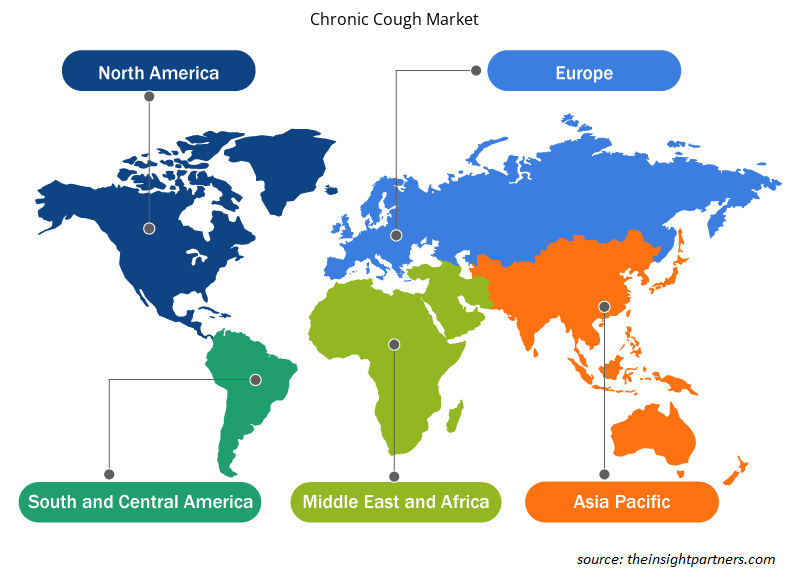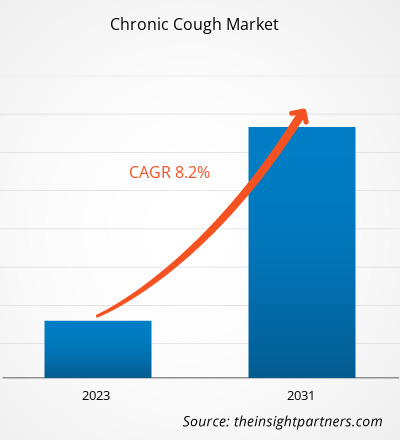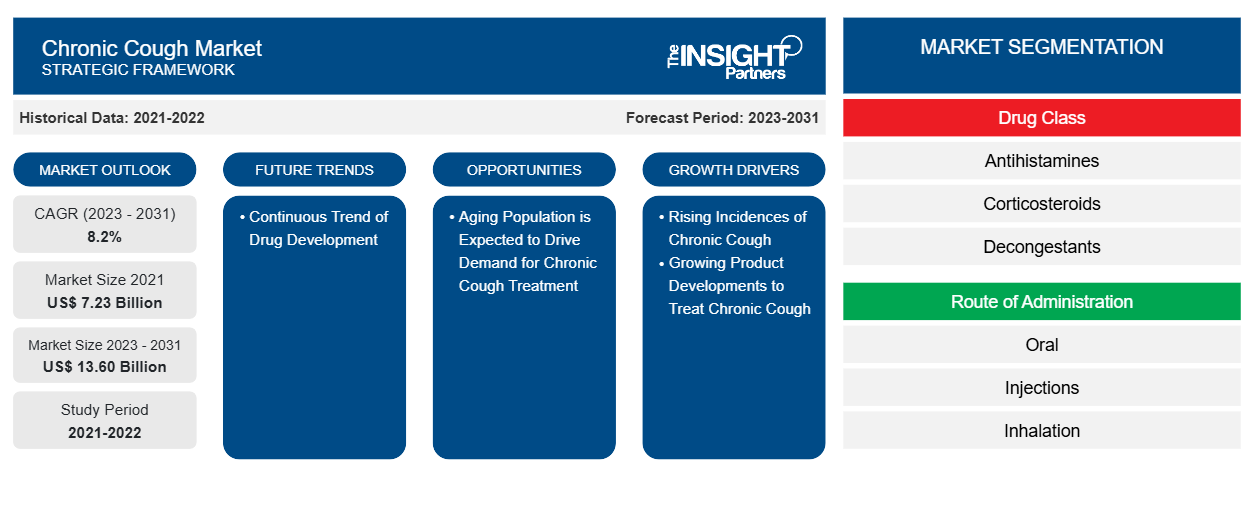El tamaño del mercado de la tos crónica en 2021 se situó en 7.230 millones de dólares y se prevé que alcance los 13.600 millones de dólares en 2031, frente a los XX mil millones de dólares en 2023. Se espera que el mercado registre una CAGR del 8,2% entre 2023 y 2031. Es probable que la creciente concienciación sobre los problemas respiratorios, junto con los avances en la investigación médica y las opciones de tratamiento, y la tendencia continua del desarrollo de fármacos sigan siendo tendencias clave del mercado de la tos crónica.CAGR of 8.2% in 2023–2031. Rising awareness regarding respiratory problems, along with advances in medical research and treatment choices, and continuous trend of drug development is likely to remain key chronic cough market trends.
Análisis del mercado de la tos crónica
El mercado mundial de la tos crónica está impulsado principalmente por la creciente prevalencia de enfermedades infecciosas pulmonares crónicas, ya que la tos persistente es una indicación frecuente, y el desarrollo de nuevos productos para tratar la tos crónica. La expansión del mercado está siendo impulsada por un cambio considerable hacia la priorización de la salud y el bienestar respiratorios, así como por iniciativas gubernamentales y no gubernamentales.prioritising respiratory health and wellness, as well as government and non-government initiatives.
Descripción general del mercado de la tos crónica
La tos crónica se prolonga durante ocho semanas o más. Las infecciones, el asma y el reflujo gástrico contribuyen a su prevalencia. Los signos y síntomas de la tos crónica incluyen una sensación de líquido que baja por la parte posterior de la garganta (goteo retronasal) y dolor de cabeza, entre otros. Carraspeo regular, dolor de garganta, ronquera, dificultad para respirar , sibilancia, olor agrio en la boca o acidez de estómago. Se ha producido un aumento de la inversión en infraestructura sanitaria, instalaciones de diagnóstico y programas de educación del paciente para mejorar el tratamiento y la detección temprana de la tos crónica.reflux sickness all contribute to its prevalence. Signs and symptoms of the chronic cough market include, a sensation of liquid running down the back of the throat (postnasal drip), and a headache, among others. Regular throat clearing, painful throat, hoarseness, odour in the mouth, or heartburn. There has been an increase in investment in healthcare infrastructure, diagnostic facilities, and patient education programmes to improve management and early detection of chronic cough.
Personalice este informe según sus necesidades
Obtendrá personalización en cualquier informe, sin cargo, incluidas partes de este informe o análisis a nivel de país, paquete de datos de Excel, así como también grandes ofertas y descuentos para empresas emergentes y universidades.
-
Obtenga las principales tendencias clave del mercado de este informe.Esta muestra GRATUITA incluirá análisis de datos, desde tendencias del mercado hasta estimaciones y pronósticos.
Factores impulsores y oportunidades del mercado de la tos crónica
La creciente adopción de la tos crónica favorece el crecimiento del mercado
Las afecciones como infecciones, enfermedades pulmonares y bronquitis también pueden provocar tos crónica. Las afecciones como el asma están aumentando a nivel mundial; se observa comúnmente entre niños y adultos. Según un estudio titulado “Prevalencia de tos crónica, sus factores de riesgo y riesgo atribuible a la población en el estudio Burden of Obstructive Lung Disease (BOLD): un estudio transversal multinacional” publicado en febrero de 2024, la prevalencia de tos crónica osciló entre el 2% y el 18%. El tabaquismo, el asma, la enfermedad pulmonar obstructiva crónica (EPOC), la obesidad, el síndrome de tos de las vías respiratorias superiores (SVAS) y la enfermedad por reflujo gastroesofágico (ERGE) son algunos de los factores que se han asociado más comúnmente con la tos crónica.COPD), obesity, upper airway cough syndrome (UACS), and gastro-oesophageal reflux disease (GORD) are some of the factors that have most commonly been associated with chronic cough.
Se espera que el envejecimiento de la población impulse la demanda del mercado de tratamiento de la tos crónica
Las personas mayores son más propensas a tener tos crónica, y la edad avanzada es el factor principal de la disminución de la inmunidad. La degeneración de los órganos y tejidos sanos debido al factor de la edad invita a varias condiciones de salud. La tos crónica es una de las condiciones de salud más comunes entre las personas mayores. El sistema respiratorio comienza a degenerarse a medida que avanza la edad. Por lo tanto, las probabilidades de sufrir infecciones respiratorias , como neumonía y gripe, aumentan en las personas mayores.
La población envejece en todo el mundo, y tanto los países desarrollados como los países en desarrollo están experimentando una disminución de la tasa de mortalidad. Los avances en el sector sanitario han mejorado la salud pública, lo que ha dado lugar a una mayor esperanza de vida. Según la OMS, en 2050 la población mundial de personas de 60 años o más alcanzará los 2.100 millones. Se espera que el número de personas de 80 años o más se triplique entre 2020 y 2050 hasta alcanzar los 426 millones. Por tanto, se espera que la creciente población geriátrica probablemente demande más tratamientos para la tos crónica durante el período previsto.
Análisis de segmentación del informe de mercado de tos crónica
Los segmentos clave que contribuyeron a la derivación del análisis del mercado de tos crónica son la clase de medicamento, la vía de administración y el canal de distribución.
- Según la clase de fármaco, el mercado de la tos crónica se segmenta en antihistamínicos, corticosteroides, descongestionantes, fármacos combinados, antibióticos, bloqueadores de ácido y otros fármacos. El segmento de fármacos combinados tuvo una mayor participación de mercado en 2023.
- Por vía de administración, el mercado se divide en oral, inyecciones, inhalación y otras vías de administración. El segmento oral tuvo la mayor participación del mercado en 2023.
- En términos de canal de distribución, el mercado está segmentado en farmacias hospitalarias, farmacias en línea y farmacias minoristas. El segmento de farmacias hospitalarias dominó el mercado en 2023.
Análisis de la cuota de mercado de la tos crónica por geografía
El alcance geográfico del informe del mercado de tos crónica se divide principalmente en cinco regiones: América del Norte, Asia Pacífico, Europa, Medio Oriente y África, y América del Sur y Central.
América del Norte ha dominado el mercado de la tos crónica. La creciente demanda de productos de venta libre (OTC) es un factor principal que se prevé que impulse el crecimiento de los ingresos de la región en el período de revisión. Además, un número cada vez mayor de casos de tos crónica, una población de ancianos en rápido crecimiento, una mayor contaminación de los vehículos y una mayor conciencia sobre los medicamentos avanzados son algunos de los otros factores que impulsan la demanda de productos para tratar la tos.
Perspectivas regionales del mercado de la tos crónica
Los analistas de Insight Partners explicaron en detalle las tendencias y los factores regionales que influyen en el mercado de la tos crónica durante el período de pronóstico. Esta sección también analiza los segmentos y la geografía del mercado de la tos crónica en América del Norte, Europa, Asia Pacífico, Oriente Medio y África, y América del Sur y Central.

- Obtenga los datos regionales específicos para el mercado de tos crónica
Alcance del informe de mercado sobre tos crónica
| Atributo del informe | Detalles |
|---|---|
| Tamaño del mercado en 2021 | 7.230 millones de dólares estadounidenses |
| Tamaño del mercado en 2031 | US$ 13.60 mil millones |
| CAGR global (2023 - 2031) | 8,2% |
| Datos históricos | 2021-2022 |
| Período de pronóstico | 2023-2031 |
| Segmentos cubiertos |
Por clase de fármaco
|
| Regiones y países cubiertos |
América del norte
|
| Líderes del mercado y perfiles de empresas clave |
|
Densidad de actores del mercado de tos crónica: comprensión de su impacto en la dinámica empresarial
El mercado de la tos crónica está creciendo rápidamente, impulsado por la creciente demanda de los usuarios finales debido a factores como la evolución de las preferencias de los consumidores, los avances tecnológicos y una mayor conciencia de los beneficios del producto. A medida que aumenta la demanda, las empresas amplían sus ofertas, innovan para satisfacer las necesidades de los consumidores y aprovechan las tendencias emergentes, lo que impulsa aún más el crecimiento del mercado.
La densidad de actores del mercado se refiere a la distribución de las empresas o firmas que operan dentro de un mercado o industria en particular. Indica cuántos competidores (actores del mercado) están presentes en un espacio de mercado determinado en relación con su tamaño o valor total de mercado.
Las principales empresas que operan en el mercado de la tos crónica son:
- Novartis AG
- Industrias farmacéuticas Teva Ltd.
- GlaxoSmithKline plc
- Bayer AG
- Mylan NV
- Productos farmacéuticos Amneal Inc.
Descargo de responsabilidad : Las empresas enumeradas anteriormente no están clasificadas en ningún orden particular.

- Obtenga una descripción general de los principales actores clave del mercado de tos crónica
Noticias y desarrollos recientes del mercado de la tos crónica
El mercado de la tos crónica se evalúa mediante la recopilación de datos cualitativos y cuantitativos a partir de una investigación primaria y secundaria, que incluye publicaciones corporativas importantes, datos de asociaciones y bases de datos. A continuación, se incluye una lista de los avances en el mercado de la tos crónica:
- Trevi Therapeutics, Inc., una empresa biofarmacéutica en fase clínica que desarrolla la terapia en investigación Haduvio (nalbufina oral de liberación prolongada) para pacientes con tos crónica en fibrosis pulmonar idiopática (FPI), tos crónica refractaria (CCR) y prurigo nodular, anunció el inicio de su ensayo clínico de fase 2b CORAL que evalúa tres dosis de Haduvio frente a placebo en aproximadamente 160 pacientes con FPI y tos crónica. (Fuente: The Trevi Therapeutics, comunicado de prensa, 2023)
- Algernon Pharmaceuticals Inc., una empresa canadiense de desarrollo de fármacos en fase clínica, se complace en anunciar que ha cerrado un acuerdo con Seyltx Inc., una empresa de desarrollo de fármacos de propiedad privada con sede en EE. UU., para la adquisición del programa de investigación NP-120 (“Ifenprodil”) de Algernon. (Fuente: Algernon Pharmaceuticals Inc., comunicado de prensa, 2024)
Informe de mercado sobre tos crónica: cobertura y resultados
El informe “Tamaño y pronóstico del mercado de tos crónica (2021-2031)” proporciona un análisis detallado del mercado que cubre las siguientes áreas:
- Tamaño del mercado y pronóstico a nivel global, regional y nacional para todos los segmentos clave del mercado cubiertos bajo el alcance
- Dinámica del mercado, como impulsores, restricciones y oportunidades clave
- Principales tendencias futuras
- Análisis detallado de las cinco fuerzas de Porter y PEST y FODA
- Análisis del mercado global y regional que cubre las tendencias clave del mercado, los principales actores, las regulaciones y los desarrollos recientes del mercado.
- Análisis del panorama de la industria y de la competencia que abarca la concentración del mercado, el análisis de mapas de calor, los actores destacados y los desarrollos recientes
- Perfiles detallados de empresas
- Análisis histórico (2 años), año base, pronóstico (7 años) con CAGR
- Análisis PEST y FODA
- Tamaño del mercado, valor/volumen: global, regional y nacional
- Industria y panorama competitivo
- Conjunto de datos de Excel
Informes recientes
Testimonios
Razón para comprar
- Toma de decisiones informada
- Comprensión de la dinámica del mercado
- Análisis competitivo
- Información sobre clientes
- Pronósticos del mercado
- Mitigación de riesgos
- Planificación estratégica
- Justificación de la inversión
- Identificación de mercados emergentes
- Mejora de las estrategias de marketing
- Impulso de la eficiencia operativa
- Alineación con las tendencias regulatorias























 Obtenga una muestra gratuita para - Mercado de la tos crónica
Obtenga una muestra gratuita para - Mercado de la tos crónica